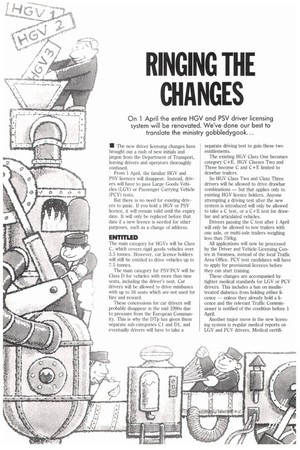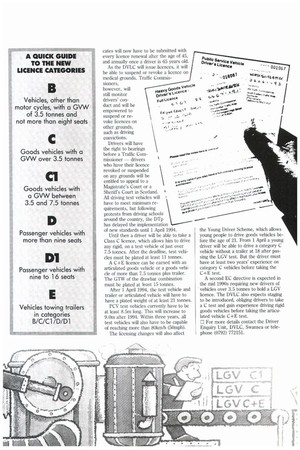RINGING THE CHANGES
Page 42

Page 43

If you've noticed an error in this article please click here to report it so we can fix it.
On 1 April the entire HGV and PSV driver licensing system will be renovated. We've done our best to translate the ministry gobbledygook...
• The new driver licensing changes have brought out a rash of new initials and jargon from the Department of Transport, leaving drivers and operators thoroughly confused.
From 1 April, the familiar HGV and PSV licences will disappear. Instead, drivers will have to pass Large Goods Vehicles (LGV) or Passenger Carrying Vehicle (PCV) tests.
But there is no need for existing drivers to panic. If you hold a HGV or PSV licence, it will remain valid until the expiry date. It will only be replaced before that date if a new licence is needed for other purposes, such as a change of address.
ENTITLED
The main category for HGVs will be Class C, which covers rigid goods vehicles over 3.5 tonnes. However, car licence holders will still be entitled to drive vehicles up to 7.5 tonnes.
The main category for PSV/PCV will be Class D for vehicles with more than nine seats, including the driver's seat. Car drivers will be allowed to drive minibuses with up to 16 seats which are not used for hire and reward.
These concessions for car drivers will probably disappear in the mid 1990s due to pressure from the European Community. This is why the Dip has given them separate sub-categories Cl and D1, and eventually drivers will have to take a separate driving test to gain these two entitlements.
The existing HGV Class One becomes category C+E. HGV Classes Two and Three become C and C+E limited to drawbar trailers.
So HGV Class Two and Class Three drivers will be allowed to drive drawbar combinations — but that applies only to existing HGV licence holders. Anyone attempting a driving test after the new system is introduced will only be allowed to take a C test, or a C+E test for drawbar and articulated vehicles.
Drivers passing the C test after 1 April will only be allowed to tow trailers with one axle, or multi-axle trailers weighing less than 750kg.
All applications will now be processed by the Driver and Vehicle Licensing Centre in Swansea, instead of the local Traffic Area Office. PCV test candidates will have to apply for provisional licences before they can start training.
These changes are accompanied by tighter medical standards for LGV or PCV drivers. This includes a ban on insulintreated diabetics from holding either licence — unless they already hold a licence and the relevant Traffic Commissioner is notified of the condition before 1 April.
Another major move in the new licensing system is regular medical reports on LGV and PCV drivers. Medical certifi cates will now have to be submitted with every licence renewal after the age of 45, and annually once a driver is 65 years old.
As the DVLC will issue licences, it will be able to suspend or revoke a licence on medical grounds. Traffic Commis sioners, however, will still monitor drivers' conduct and will be empowered to suspend or revoke licences on other grounds, such as driving convictions.
Drivers will have the right to hearings before a Traffic Commissioner — drivers who have their licence revoked or suspended on any grounds will be entitled to appeal to a Magistrate's Court or a " Sheriff's Court in Scotland. I •, All driving test vehicles will • have to meet minimum re quirements, but following protests from driving schools
oh dPle'
around the country, the Dip has delayed the implementation of new standards until 1 April 1994.
Until then a driver will be able to take a Class C licence, which allows him to drive any rigid, on a test vehicle of just over 7.5 tonnes. After the deadline, test vehicles must he plated at least 11 tonnes.
A C+E licence can be earned with an articulated goods vehicle or a goods vehicle of more than 7.5 tonnes plus trailer. The GTW of the drawbar combination must be plated at least 15 tonnes.
After 1 April 1994, the test vehicle and trailer or articulated vehicle will have to have a plated weight of at least 21 tonnes_ PCV test vehicles currently have to be at least 8.5m long. This will increase to 9.0m after 1994. Within three years, all test vehicles will also have to be capable of reaching more than 80krn/h (50mph).
The licensing changes will also affect
the Young Driver Scheme, which allows young people to drive goods vehicles before the age of 21. From 1 April a young driver will be able to drive a category C vehicle without a trailer at 18 after passing the LGV test, But the driver must have at least two years' experience on category C vehicles before taking the C+E test.
A second EC directive is expected in the mid 1990s requiring new drivers of vehicles over 3.5 tonnes to hold a LGV licence. The DVLC also expects staging to be introduced, obliging drivers to take a C test and gain experience driving rigid goods vehicles before taking the articulated vehicle C+E test.
For more details contact the Driver Enquiry Unit, DVLC, Swansea or telephone (0792) 772151.








































































































